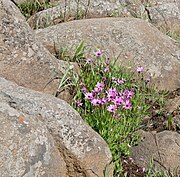
Osteospermum, is a genus of flowering plants belonging to the Calenduleae, one of the smaller tribes of the sunflower/daisy family Asteraceae. They are known as the daisybushes or African daisies.
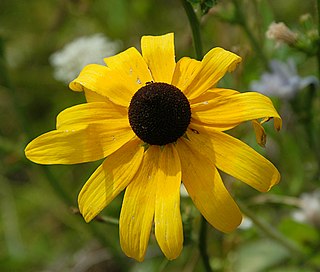
Rudbeckia hirta, commonly called black-eyed Susan, is a North American flowering plant in the family Asteraceae, native to Eastern and Central North America and naturalized in the Western part of the continent as well as in China. It has now been found in all 10 Canadian Provinces and all 48 of the states in the contiguous United States.

Anacyclus pyrethrum, the pellitory, Spanish chamomile, Mount Atlas daisy, or Akarkara, is a species of flowering plant in the daisy family Asteraceae. It is native to Mediterranean Europe and parts of North Africa, but also naturalised in other parts of Europe, India and Pakistan. This herbaceous perennial resembles chamomile species in habitat and appearance.

Strelitzia reginae, commonly known as the crane flower, bird of paradise, or isigude in Nguni, is a species of flowering plant indigenous to South Africa. An evergreen perennial, it is widely cultivated for its dramatic flowers. In temperate areas it is a popular houseplant.
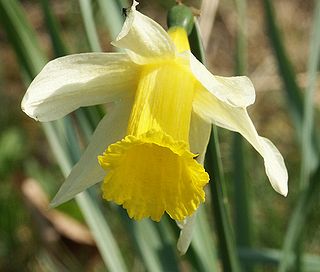
Narcissus pseudonarcissus is a perennial flowering plant.

Dimorphotheca sinuata, the glandular Cape marigold, Namaqualand daisy, or orange Namaqualand daisy; syn. Dimorphotheca aurantiaca hort.) is an African species of plants native to southern Africa. It is also widely cultivated as an ornamental and naturalized in parts of the United States, primarily California and Arizona.

Symphyotrichum lateriflorum is a species of flowering plant of the aster family (Asteraceae) native to eastern and central North America. Commonly known as calico aster, starved aster, and white woodland aster, it is a perennial, herbaceous plant that may reach 120 centimeters high and 30 centimeters across. Each flower head has many tiny florets put together into what appear as one.

Calenduleae is a flowering plant tribe of the family Asteraceae. Calenduleae has been widely recognized since Alexandre de Cassini in the early 19th century. There are eight genera and over 110 species, mostly found in South Africa.

Dimorphotheca is a genus of plants in the sunflower family, native to Africa and Australia. is one of eight genera of the Calenduleae, with a centre of diversity in Southern Africa. Some species can hybridize with Osteospermum, and crosses are sold as cultivated ornamentals. The name "Dimorphotheca" comes from the Greek "Dis" "Morphe" and "Theka", meaning "two shaped fruit", referring to the dimorphic cypselae, a trait inherent to members of the Calenduleae. Plants of this genus usually have bisexual flowers.
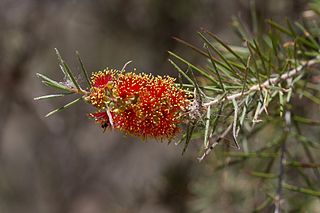
Melaleuca brachyandra, commonly known as prickly bottlebrush or scarlet bottlebrush, is a plant in the myrtle family, Myrtaceae and is endemic to New South Wales, Victoria and South Australia in Australia. It is a shrub or small tree with narrow leaves and showy red and green flowers making it an ideal ornamental plant in temperate areas.

Tulbaghia violacea, known as society garlic is a species of flowering plant in the family Amaryllidaceae, indigenous to southern Africa, and reportedly naturalized in Tanzania and Mexico.

Lotus hirsutus, also known by the synonym Dorycnium hirsutum, common name: canary clover or hairy canary-clover, is a species of flowering plant in the legume family Fabaceae.
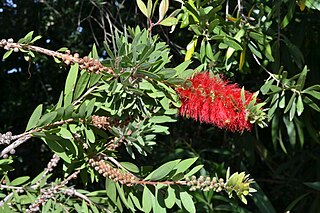
Melaleuca citrina, commonly known as common red bottlebrush, crimson bottlebrush, or lemon bottlebrush, is a plant in the myrtle family Myrtaceae, and is endemic to New South Wales and Victoria in Australia. Some Australian state herbaria continue to use the name Callistemon citrinus. Callistemon lanceolatus is an older name. It is a hardy and adaptable species, common in its natural habitat. It is widely cultivated, not only in Australia, often as a species of Callistemon. It was one of the first Australian plants to be grown outside the country, having been taken to England in 1770 by Joseph Banks. Its showy red flower spikes, present over most of the year in an ideal situation, account for its popularity.
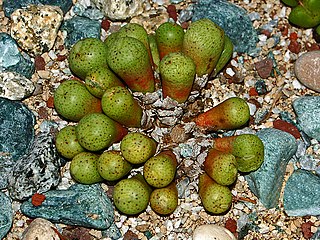
Conophytum jucundum is a species of succulent plants belonging to the family Aizoaceae. As its synonym Conophytum gratum, the pleasing cone plant, it has gained the Royal Horticultural Society's Award of Garden Merit.
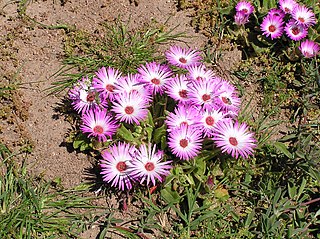
Cleretum bellidiforme, commonly called Livingstone daisy, Bokbaaivygie (Afrikaans), or Buck Bay vygie, is a species of flowering plant in the family Aizoaceae, native to the Cape Peninsula in South Africa. It is a low-growing succulent annual growing to 25 cm (10 in), and cultivated for its iridescent, many-petalled, daisy-like blooms in shades of white, yellow, orange, cream, pink and crimson. In temperate areas it is popularly grown as a half-hardy annual, and lends itself to mass plantings or as edging plants in summer bedding schemes in parks and gardens. It is still widely referenced under its former names, Mesembryanthemum criniflorum and Dorotheanthus bellidiformis.

Dimorphotheca pluvialis, common names white African daisy, Cape marigold, weather prophet, Cape rain-daisy, ox-eye daisy, Cape daisy or rain daisy, is a plant species native to South Africa and Namibia. It is sparingly naturalized in scattered locations in California.

Genista sagittalis, called the arrow-jointed broom and winged broom, is a species of flowering plant in the genus Genista, native to central and southern Europe, Ukraine, and Anatolia. Its subspecies Genista sagittalis subsp. delphinensis, called rock broom, has gained the Royal Horticultural Society's Award of Garden Merit.
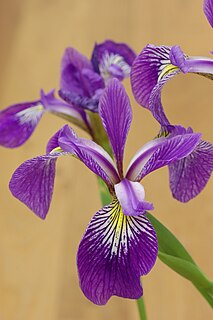
Iris × robusta, called the Windermere iris, is a hybrid species of flowering plant in the family Iridaceae. Its parents are Iris versicolor and Iris virginica, both of which are native to North America. Wild populations have been found in Michigan and Ontario, and it has been introduced into Great Britain. It is a rhizomatous perennial, characterised by its violet-blue flowers and purple-flushed foliage. It has a number of cultivars, including 'Gerald Darby', 'Mountain Brook', 'Purple Fan' and 'Nutfield Blue'. Its cultivar 'Dark Aura' has gained the Royal Horticultural Society's Award of Garden Merit.
Tulbaghia leucantha, the mountain wild garlic, is a species of flowering plant in the family Amaryllidaceae, widely distributed in southern Africa. It has gained the Royal Horticultural Society's Award of Garden Merit as an ornamental.

Diascia barberae, called twinspur along with other members of its genus, is a species of flowering plant in the family Scrophulariaceae, native to South Africa and Lesotho. Its cultivar 'Blackthorn Apricot' has gained the Royal Horticultural Society's Award of Garden Merit. Many other cultivars that vary largely by the color of their flowers are available, including 'Ruby Field', 'Lilac Belle' and 'Rupert Lambert'.

